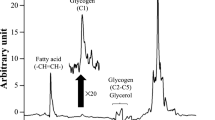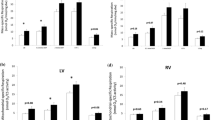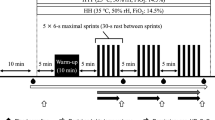Summary
Twelve male Sprague-Dawley rats (21 days old) were randomly assigned into two experimental groups: sea level control (CONT) and hypobaric hypoxia (HYPO). The HYPO rats were kept in an hypobaric chamber maintaining a simulated altitude of 4000 m (61.1 kPa). After 10 weeks of treatment, the rat hindlimb muscles [soleus (SOL) and extensor digitorum longus (EDL)] were subjected to histochemical and electro-mechanical analyses. Results indicated that compared to CONT the HYPO SOL muscle had a significantly greater relative distribution of fast-twitch-oxidative-glycolytic (FOG) fibres (28.9% SEM 2.0 vs 18.3% SEM 1.8,P<0.01) with a significant decrease in slow twitch oxidative fibre distribution (69.5% SEM 2.4 vs 82.9% SEM 3.1,P<0.01). Compared to CONT the HYPO EDL muscle also manifested a significant increase in FOG fibre distribution (51.6% SEM 0.8 vs 46.6% SEM 1.1,P<0.01), but this was accompanied by a significant decrease in fast twitch glucolytic fibres (44.3% SEM 0.9 vs 49.2% SEM 1.7,P<0.05). These histochemical fibre type transformations accompanied significant and expected changes in the electro-mechanical parameters tested in situ, e.g. maximal twitch force, maximal rate of force development, contraction time, half relaxation time, force:frequency curve, and fatigability. It was concluded that chronic hypobaric hypoxia could have a potent influence upon the phenotype expression of muscle fibres.
Similar content being viewed by others
References
Baldwin KM, Roy RR, Sacks RD, Blanco C, Edgerton VR (1984) Relative independence of metabolic and neuromuscular activity. J Appl Physiol 56:1602–1607
Barnard RJ, Edgerton VR, Furukawa T, Peter JR (1971) Histochemical, biochemical and contractile properties of red, white and intermediate fibers. Am J Physiol 220:410–414
Burke RE, Edgerton VR (1975) Motor unit properties and selective involvement in movement. Exerc Sport Sci Rev 3:31–81
Burke RE, Levine DN, Tsairis P, Zajac FE (1973) Physiological types and histochemical profiles in motor units of the cat gastrocnemius. J Physiol (Lond) 234:723–748
Cassin S, Gilbert RD, Bunnell CE, Johnson EM (1971) Capillary development during exposure to chronic hypoxia. J Appl Physiol 220:448–451
Close R (1964) Dynamic properties of fast and slow skeletal muscles of the rat during development. J Physiol (Lond) 173:74–95
Close R (1972) Dynamic properties of mammalian skeletal muscles. Physiol Rev 52:129–197
Davies AS, Gunn HM (1972) Histochemical fiber types in the mammalian diaphragm. J Anat 112:41–60
Edgerton VR, Goslow GE Jr, Rasmussen SA, Spector SA (1980) Is resistance of a muscle to fatigue controlled by its motoneurones? Nature (Lond) 285:589–590
Green HJ, Klug GA, Reichmann H, Seedorf U, Wiehrer W, Pette D (1984) Exercise-induced fiber type transitions with regard to myosin, parvalbumin, and sarcoplasmic reticulum in muscles of the rat. Pflügers Arch 400:432–438
Guth L, Samaha F (1969) Contractile and histochemical properties of regenerating cross-transplanted fast and slow muscles in the rat. Pflügers Arch 353:227–239
Guy PS, Snow DH (1977) The effect of training and detraining on muscle composition in the horse. J Physiol (Lond) 269:33–51
Henriksson J, Svedenhag J, Richter EA, Christensen NJ, Galbo H (1985) Skeletal muscle and hormonal adaptation to physical training in the rat: role of the sympatho-adrenal system. Acta Physiol Scand 123:127–138
Hoh JFY, Yeoh GPS (1979) Rabbit skeletal muscle myosin isoenzymes from fetal fast- and slow-twitch muscles. Nature 280:321–323
Ishihara A, Taguchi S, Itoh M, Itoh K (1990) Oxidative metabolism of the rat soleus neuron pool following hypobaric hypoxia. Brain Res Bull 24:143–146
Itoh K, Ito M, Taguchi S, Ishihara A (1988) Effects of hypobaric-hypoxia on the total number and histochemical properties of the soleus muscle fibers and motoneurons in the rat. J Physiol Soc Jpn 50:163–168
Jones DA, Bigland-Ritchie B, Edwards RHT (1979) Excitation frequency and muscle fatigue: mechanical responses during voluntary and stimulated contractions. Exp Neurol 64:401–413
Lomo T, Westgaard RH, Engebretsen L (1980) Different stimulation patterns affect contractile properties of denervated rat solens muscles. In: Pette D (ed) Plasticity of muscle. de Gruyter, New York, pp 297–309
Martin TP, Edgerton VR, Grindeland RE (1988) Influence of spaceflight on rat skeletal muscle. J Appl Physiol 65:2318–2325
Miller JB, Stockdale FE (1987) What muscle cells know that nerves don't tell them. Trend Neurosci 10:325–329
Moritani T, Muro A, Kijima A (1985) Electromechanical changes during electrically induced and maximal voluntary contractions: electrophysiologic responses of different muscle fiber types during stimulated contractions. Exp Neurol 88:471–483
Moritani T, Berry MJ, Bacharach DW, Nakamura E (1987) Gas exchange parameters, muscle blood flow and electromechanical properties of the plantar flexors. Eur J Appl Physiol 56:30–37
Padykula HA, Herman E (1955) The specificity of the histochemical method for adenosine triphosphatase. J Histochem Cytochem 3:170–195
Saltin B, Gollnick PD (1983) Skeletal muscle adaptability: significance for metabolism and performance. In: Peachey LD (ed) Handbook of physiology: skeletal muscle, section 10, chapter 19. American Physiological Society, Bethesda, Md, pp 555–631
Taguchi S, Avakian EV, Borgia JF, Horvath SM (1984) Effect of perinatal hypobaric hypoxia on biochemical indices of energy metabolism in cardiac and skeletal muscle. Fed Proc 43:906P
Taguchi S, Hata Y, Itoh K (1985) Enzymatic responses and adaptations to swimming training and hypobaric hypoxia in postnatal rats. Jpn J Physiol 35:1023–1032
Templeton GH, Sweeney HL, Timson BF, Padalino M, Dudenhoeffer GA (1988) Changes in fiber composition of soleus muscle during rat hindlimb suspension. J Appl Physiol 65:1191–1195
Tureck Z, Grandtner M, Kreuzer F (1972) Cardiac hypertrophy, capillary and muscle fiber density, muscle fiber diameter, capillary radius and diffusion distance in the myocardium of growing rats adapted to a simulated altitude of 3500 m. Pflüg-ers Arch 335:19–28
Vrbova G (1979) Influence of activity on some characteristic properties of slow and fast mammalian muscles. Exerc Sport Sci Rev 7:181–213
Author information
Authors and Affiliations
Rights and permissions
About this article
Cite this article
Itoh, K., Moritani, T., Ishida, K. et al. Hypoxia-induced fibre type transformation in rat hindlimb muscles. Europ. J. Appl. Physiol. 60, 331–336 (1990). https://doi.org/10.1007/BF00713495
Accepted:
Issue Date:
DOI: https://doi.org/10.1007/BF00713495




